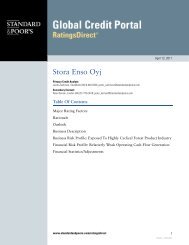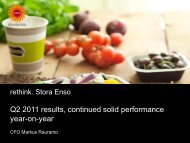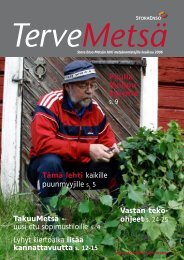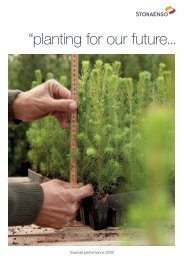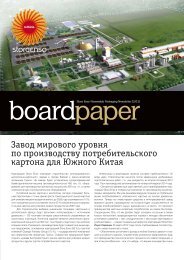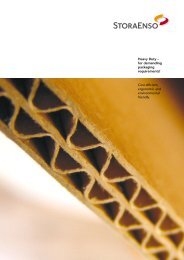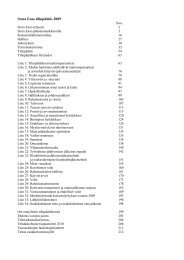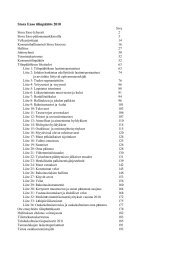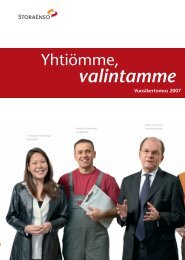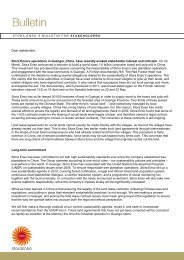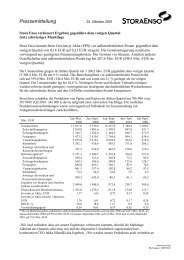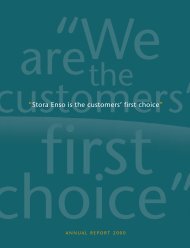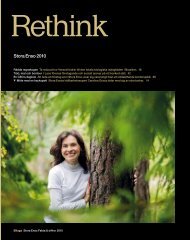Question and Answer Session - Stora Enso
Question and Answer Session - Stora Enso
Question and Answer Session - Stora Enso
Create successful ePaper yourself
Turn your PDF publications into a flip-book with our unique Google optimized e-Paper software.
<strong>Stora</strong> <strong>Enso</strong><br />
Q1 Results 2009<br />
Keith Russell<br />
Senior Vice President IR<br />
Good. Thank you Hugh. Welcome everybody to today's webcast <strong>and</strong> conference call for the<br />
financial community.<br />
Earlier today we published our financial results for the first quarter of 2009, but also two other<br />
releases. One introducing a new EUR250m cost reduction programme plus some changes to our<br />
business area structure. And another relates to capacity reductions for our Wood Products business<br />
area plus the purchase of the remaining shareholding in the Sunila pulp mill in Finl<strong>and</strong>.<br />
On today's call we'll be highlighting key points on these announcements <strong>and</strong> following these<br />
remarks, as Hugh said, of course we'll open it up for questions. Our CEO, Jouko Karvinen is<br />
leading the call <strong>and</strong> we're joined also by our CFO Markus Rauramo.<br />
As usual we'll try to keep the event to about one hour. So I therefore ask politely that those who<br />
would like to ask questions, at least initially, limit themselves to two each. And then of course if we<br />
have time at the end, we're more than happy to come back <strong>and</strong> take any additional questions then.<br />
If you're not listening by the webcast, the set of PowerPoint slides that we'll be referring to can be<br />
seen now in the Investor section of <strong>Stora</strong>enso.com where you can also find the full press releases<br />
issued earlier today.<br />
Finally, I'll just draw your attention to page number two of the PowerPoint presentation which is an<br />
important notice concerning forward looking statements.<br />
So I'll now turn the microphone over to Jouko Karvinen. Thank you.<br />
Jouko Karvinen<br />
Chief Executive Officer<br />
Thank you Keith. Hello everybody. Welcome back so to say. Good to have you on the call. We'll<br />
try to be brief.<br />
If you go straight to page three we'll cover the first quarter, a very short term market outlook <strong>and</strong><br />
then I'll talk briefly about the next step on our journey to make this a more efficient, not only cost<br />
efficient, but faster decision making Company.<br />
We have a unique subject in a way where we talk about Finl<strong>and</strong>, the operating environment in<br />
Finl<strong>and</strong> with <strong>Stora</strong> <strong>Enso</strong> <strong>and</strong> many others, how do we deal with that in the short term as a company<br />
<strong>and</strong> how we have pretty clearly communicated to all the stakeholders what needs to change. And<br />
then we'll summarize.
Q1 Earnings Results 2009 <strong>Stora</strong> <strong>Enso</strong><br />
We'll go to page five I believe, the overview.<br />
Cash flow from operations, EUR264m. Even after CapEx it was a pretty decent number. And yes,<br />
it was driven by a continued strong working capital management as we promised. And we do<br />
underst<strong>and</strong> obviously that you can't multiply that by 4 or anything, but I think it was a strong start in<br />
an exceptional environment for the year for the second quarter in a row now. So we're very proud<br />
of that <strong>and</strong> the team who made that happen.<br />
Operating earnings, went down to EUR3m, an awful result. I even implied in the press release that<br />
the truth of the matter is that we actually made a, I'll call it a very material profit. I won't quantify it,<br />
so don't ask me about that in <strong>Stora</strong> <strong>Enso</strong> outside Finl<strong>and</strong> total. And then we lost it all but EUR3m<br />
in Finl<strong>and</strong>. And that obviously is not an acceptable situation. We'll talk about that a bit more.<br />
Trying to underst<strong>and</strong> the market expectations from you, all the different thoughts, I believe that the<br />
earnings were, at least on a pure operational level, pretty much in line, maybe slightly better. But<br />
interesting enough the volume was clearly worse than the market seemed to expect.<br />
I want to turn it into a positive thing <strong>and</strong> say with the hard work we've done in the past years, even<br />
with this dramatic curtailment programme, we were able to keep at least our nose above the water.<br />
Why is it important? Because fixed cost is the enemy of anybody right now <strong>and</strong> I think the things<br />
we've done in the past two years, <strong>and</strong> we shall do now, are very important. And the EUR78m year<br />
on year gain on fixed cost I'm sure Markus will talk about that a bit more.<br />
Looking at the rear view mirror, in Newsprint, Magazine, Coated Fine <strong>and</strong> Consumer Board, we<br />
were able to reach <strong>and</strong> hold higher prices, which I believe is because we started pretty early <strong>and</strong><br />
have been very clear with our customers what our priorities are <strong>and</strong> so far so good in that respect.<br />
Page six. Many of you have been a lot longer in the industry than I have, but I would assume that<br />
you haven't seen many slides like this in the past 10, 20 years, where effectively one-quarter of our<br />
total capacity was down. Again, I say it was a conscious decision <strong>and</strong> I believe it has been the right<br />
decision <strong>and</strong> that's how we continue.<br />
Let me then h<strong>and</strong> over to Markus who will review the financial results with you.<br />
Markus Rauramo<br />
Chief Financial Officer<br />
Okay, thanks Jouko. Moving on to page eight, to the summary financials.<br />
Looking at the results row, our result although positive, was a very weak EUR3m. This number is<br />
obviously unacceptably low. The positive thing was that all of our efforts to protect cash flow were<br />
successful. We did focus on inventory management, receivables <strong>and</strong> payables, paid provisions <strong>and</strong><br />
CapEx. And all this work resulted in very strong cash flow from operations of EUR264m. So<br />
result EUR3m, cash flow from operations EUR264m. And even after CapEx, the cash flow was<br />
EUR160m positive.<br />
23 April 2009 2
Q1 Earnings Results 2009 <strong>Stora</strong> <strong>Enso</strong><br />
The other item that makes me very happy is our debt to equity. Our net debt reduced by EUR175m<br />
<strong>and</strong> despite the fact that our equity reduced as well, our debt to equity actually improved by 1 point.<br />
I will come back to liquidity later because that is as or even more important.<br />
Moving on to page nine, to the waterfall of the operating profit. As you did see on the last page, the<br />
results came down almost EUR140m year on year. As we all know, the drop was of course mostly<br />
driven by the very sharp drop in dem<strong>and</strong> causing a decrease of way over EUR200m of the result.<br />
Energy costs, as anticipated, were still higher in the first quarter of 2009 due to the fact that we have<br />
an average six month delay of oil price impact in natural gas prices <strong>and</strong> the negative effect of oil<br />
hedges.<br />
However, we were able to counter over EUR100m of this loss of profit with our own actions. If we<br />
had not taken the actions we took in 2007 <strong>and</strong> 2008 to reduce costs, we would have shown a loss in<br />
Q1.<br />
Moving on to CapEx <strong>and</strong> depreciation on page 10, you see the quarterly development of CapEx.<br />
And as the visibility is very poor <strong>and</strong> the assumptions for CapEx are very volatile, in order to<br />
protect our cash flow we decided to take down our CapEx to the level of EUR400m for 2009. The<br />
Q1 CapEx was EUR100m, well in line with this target.<br />
Although the reduction from last year is significant, we are still keeping the focus on our strategy<br />
<strong>and</strong> continue to invest in efficient energy solutions in Germany, Belgium <strong>and</strong> Pol<strong>and</strong> as well as<br />
plantation projects in fast growth areas like China.<br />
If things would get even worse than they are today, I want to emphasise that we still have room to<br />
take our CapEx clearly lower without jeopardizing the runability of our machines, without<br />
jeopardizing the safety at workplaces. Of course it takes a bit of time, a few quarters to adjusting<br />
the strategic spending, but we have flexibility on that side as well.<br />
If we then turn to page 11 <strong>and</strong> look more specifically at the quarterly cash flow, we have said this<br />
before but I want to emphasise this again. We did take early action to protect our balance sheet <strong>and</strong><br />
cash flow. When the first wave of the financial crisis hit the market back in the late summer of<br />
2007, we immediately started reducing our short term debts, which we have reduced by over<br />
EUR1b <strong>and</strong> deleveraging the balance sheet by the divestment of <strong>Stora</strong> <strong>Enso</strong> North America, of<br />
Papyrus <strong>and</strong> so on. We have reduced the CapEx from a level of EUR900m to EUR600m at the end<br />
of last year <strong>and</strong> now further to EUR400m for 2009.<br />
And even though the bars you can see here on the operating side include the cash out relating to our<br />
mill closures, we have managed to create between EUR200m <strong>and</strong> EUR300m per quarter cash flow<br />
<strong>and</strong> positive cash flow after the CapEx for the four last quarters.<br />
And this is really thanks to the very hard <strong>and</strong> diligent work of the whole <strong>Stora</strong> <strong>Enso</strong> team, which I'm<br />
very impressed of. And I really want to extend my personal thanks to our whole team for the great<br />
work they are doing with the cash flow.<br />
The cash flow from operations, to summarise in Q1, was a fantastic EUR260m. But it is very<br />
important to emphasise of course that we will not be able to replicate this every quarter since this<br />
very good cash flow is largely due to very efficient working capital management.<br />
23 April 2009 3
Q1 Earnings Results 2009 <strong>Stora</strong> <strong>Enso</strong><br />
Then over to liquidity on page 12. The key point here is that our cash exceeds this year's debt<br />
maturities. We have put extra emphasis on the balance sheet <strong>and</strong> liquidity management since mid<br />
2007 as we think that a strong balance sheet <strong>and</strong> good liquidity are vital for the Company. We will<br />
of course survive this storm but we want to come out as winners. Survival is not enough. We want<br />
to win.<br />
The strong balance sheet <strong>and</strong> liquidity gives us strategic flexibility to continue the internal<br />
restructuring. As per the announcement also today, 2,000 people <strong>and</strong> we will have relating costs,<br />
will leave the Company. We want to implement that strategy organically <strong>and</strong> we want to be able to<br />
participate as an active player in the possible industry restructuring.<br />
As said, we have more cash than debt maturities in 2009. And in addition to that we focus on<br />
keeping our cash flow clearly positive in 2009.<br />
In addition to this we have very good access to committed liquidity without covenants, without<br />
restrictions for use. We are financially strong <strong>and</strong> we will win.<br />
Then over to the market outlook, moving on to page 14, you're probably familiar with the RISI<br />
forecasts. And you can see the development as RISI has also taken their assumption of dem<strong>and</strong><br />
development down.<br />
On our end we have been planning for a clearly weaker dem<strong>and</strong> than what RISI has at any point<br />
forecasted. So early on, back late last year, we asked our businesses to plan for clearly weaker<br />
scenarios. And of course that has given us time to think <strong>and</strong> plan <strong>and</strong> manage our capacity in an<br />
orderly way.<br />
Needless to say, when we have seen what the deliveries are for the whole industry, we think RISI is<br />
still too optimistic <strong>and</strong> we plan for something different. We focus very much on the pricing quality.<br />
We focus very much on our inventory management.<br />
Moving on to page 15, in short, the outlook for Q2 is more of the same - weak dem<strong>and</strong>, very untransparent<br />
situation, very poor visibility. The positive thing is that we have taken our forecast<br />
deflation down, excluding internal actions, to 4%. A large part of this is reduced fibre cost <strong>and</strong> then<br />
on top of this internal actions. You saw the impact on the first quarter which is substantial.<br />
Now I will h<strong>and</strong> over to Jouko who will talk about what we're planning for the future.<br />
Jouko Karvinen<br />
Chief Executive Officer<br />
Okay, thank you Markus. I'll be brief. I'm repeating myself. The 4 to 5 margin point gain through<br />
the mostly operation related restructuring I think is a critical mission right now. But given the fact<br />
that the world is tougher than any of us thought maybe six, seven months ago, or maybe even<br />
tougher than any of you thought, we can't stop. We have to take the next step as we call it. And<br />
now there are two sides to that story.<br />
23 April 2009 4
Q1 Earnings Results 2009 <strong>Stora</strong> <strong>Enso</strong><br />
One, it is another 2 to 3 margin points of fixed costs out. But it is also because it is focused on<br />
management structures, simplifying them, speeding our decision making <strong>and</strong> administration. It's<br />
also a bit different because now we try to pretty much make sure that we don't burden our core<br />
businesses <strong>and</strong> try to empower them to make decisions even faster <strong>and</strong> even more business <strong>and</strong><br />
customer driven.<br />
You may or may not remember, when I joined the Company two years ago, one of the first steps we<br />
did was that we actually took out one layer of the organization. And some of you may remember<br />
that we used to have a Publication division <strong>and</strong> a Packaging division. No, we're not going back.<br />
We're not adding a layer. And to be specific also which I think is interesting to you, is that we will<br />
not reduce our transparency. I.e. we will continue to report in Newsprint <strong>and</strong> Book, Magazine, so<br />
forth <strong>and</strong> so on even though we consolidate the organization.<br />
I believe that if you go then to page 18, you see the simplicity. Publication Paper which is the<br />
Newsprint, Book <strong>and</strong> Magazine, Packaging, Consumer Board <strong>and</strong> Industrial Packaging. Fine Paper<br />
<strong>and</strong> Wood Products, no structural change.<br />
There is also one more strategic thought <strong>and</strong> that is that when now I see that after the 10 years of<br />
talking of consolidation of the industry, I see that sooner or later the environment will force a<br />
change. I would like to have fairly strong, fairly independent businesses that can participate also in<br />
possible segment based consolidations.<br />
What I mean with that, <strong>and</strong> I have long experience myself in integrating things, is that it is difficult<br />
to do these structural changes if they're very deeply integrated into a Group level organization. And<br />
I also think that for the operational freedom of the businesses, now that they have more direct<br />
control of their fibre costs <strong>and</strong> so forth, logistics is important.<br />
We've said the majority of the cost savings will happen by the end of the year. Mathematically it<br />
means that the impact of this programme isn't significant for '09. It is significant for '10 <strong>and</strong> then<br />
'11.<br />
Markus you want to talk about the Sawn Wood business?<br />
Markus Rauramo<br />
Chief Financial Officer<br />
Yes. As Jouko said, we made three releases today <strong>and</strong> one of them was concerning reductions in<br />
Sawn Wood capacity <strong>and</strong> Sunila.<br />
On slide 19, we talk about the sawn goods part. We are facing an extended dem<strong>and</strong> downturn <strong>and</strong><br />
over capacity continues to be heavy in Europe. And also the raw material supply is challenging<br />
both in the Baltic Sea area <strong>and</strong> in Central Europe. But the severest challenge we still have in<br />
Finl<strong>and</strong>. And today we'll start codetermination negotiations in Finl<strong>and</strong> to reduce capacity in Kitee<br />
<strong>and</strong> Varkaus <strong>and</strong> also to restructure Puumerkki. These actions will reduce the annual capacity by a<br />
total of 120,000 cubic meters of sawn goods.<br />
23 April 2009 5
Q1 Earnings Results 2009 <strong>Stora</strong> <strong>Enso</strong><br />
Also we are planning to take long term production curtailments in Pol<strong>and</strong> <strong>and</strong> one sawing line in<br />
Austria. And this will reduce the annual capacity by 220,000 cubic meters <strong>and</strong> of course these<br />
measures as well are subject to local codetermination as required.<br />
These <strong>and</strong> previous actions that we have taken recently amount to long term reductions of annual<br />
capacity of 800,000 cubes which is actually 11% of our capacity a year earlier.<br />
Then if we go to page 20, we talk about Sunila. And we have announced today that we will acquire<br />
Myllykoski Paper's remaining 49% shareholding in Sunila Oy for EUR6m. And the expected net<br />
purchase price after balance sheet adjustment is then EUR3m. This transaction is subject to<br />
competition authority approval <strong>and</strong> we expect that the transaction closes by end of second quarter<br />
this year.<br />
We are striving proactively to improve our profitability <strong>and</strong> secure a better future for the whole<br />
Group. And the reason why we acquired this 49%, we think in the current very challenging<br />
operating environment it's easier for <strong>Stora</strong> <strong>Enso</strong> to optimize our own pulp production <strong>and</strong> be a<br />
supplier to Myllykoski Paper as the sole owner of Sunila Pulp Mill. We have also agreed to supply<br />
Myllykoski Paper with pulp for the next three years <strong>and</strong> Harvestia will continue wood deliveries to<br />
<strong>Stora</strong> <strong>Enso</strong>.<br />
And accounting wise, if we get the competition authority approval, we will consolidate Sunila after<br />
the closing of this transaction.<br />
We also mentioned in the beginning that we do have specific issues in Finl<strong>and</strong> <strong>and</strong> I want to<br />
highlight a couple of issues on page 22.<br />
On this slide we have plotted our mills in one product segment. The bars in grey are Finnish mills<br />
<strong>and</strong> the bars in orange are mills outside of Finl<strong>and</strong>. And if you assume that by product we have<br />
taken 20% to 30% curtailment due to lack of orders, to lack of profitability, being able to run<br />
profitable orders as we said, we curtailed the high cost units. We run the lower cost units. The<br />
country plays no role. The cost base is the determining factor.<br />
But what comes to Finnish mills, you can see also in this product segment where the highest cost<br />
mill is which gets curtailed first, unfortunately. And if we look at the whole forest industry <strong>and</strong><br />
compare European countries <strong>and</strong> countries outside of Europe, unfortunately the Finnish cost level<br />
has developed in the wrong way. And Finl<strong>and</strong> has some serious issues to solve to be back in the<br />
competition. This concerns the whole value chain from taxation to wood cost, to production cost,<br />
logistics, fuel taxes etc.<br />
Jouko Karvinen<br />
Chief Executive Officer<br />
Good. Thank you, Markus. One more slide <strong>and</strong> then it's for you people to ask questions. Page 24,<br />
the summary.<br />
Even if we sound boring, Q2 is more of the same. As tough, dem<strong>and</strong>ing as Q1, or for that matter,<br />
23 April 2009 6
Q1 Earnings Results 2009 <strong>Stora</strong> <strong>Enso</strong><br />
Q4. Many people, especially the media, asked me today ‘well, but we've heard there's some good<br />
vibrations’. I think that was one wording. And then everybody obviously reads some of the<br />
politicians' hopes. And I said that the rule in <strong>Stora</strong> <strong>Enso</strong> is: ‘the good times are back when we see<br />
material improvement in order intake, actual’.<br />
If I look at the forecasting capability of anybody before the market went off the cliff, I don't see any<br />
reason to start planning the future of this Company on some hope. And therefore, we will continue<br />
to run the Company in the same manner we've run it since October, which is when we have our<br />
New Year's events. That's when we started this year.<br />
Curtail aggressively higher cost assets, focus on cash flow <strong>and</strong> margin quality <strong>and</strong> yes, control<br />
capital spending <strong>and</strong> expenses. That's the short term ride out of the storm concept I would say.<br />
And yes, we will reduce fixed costs by a further 2 to 3 margin points. It will not be easy. It will be<br />
very tough on our personnel. But I do hope that our track record from the past two years<br />
demonstrates to also you, that when we say we're going to do something, we mean business. We're<br />
going to get it done.<br />
We don't expect a short term recovery. And the important thing is, even with the issues in Finl<strong>and</strong><br />
<strong>and</strong> so forth, we believe we have both the balance sheet but also the management strength to ride<br />
out the storm <strong>and</strong> be one of the winners. Thank you.<br />
Lars Kjellberg – Credit Suisse<br />
<strong>Question</strong> <strong>and</strong> <strong>Answer</strong> <strong>Session</strong><br />
Yes, hi. I have a couple of questions. Starting with costs, 4% cost deflation, excluding your own<br />
efforts, can you give us a number what you think you can achieve yourself?<br />
Jouko Karvinen – <strong>Stora</strong> <strong>Enso</strong><br />
Okay. We've tried to be consistent in terms of how do we define the deflation before the actions.<br />
I'm talking this through, if you remember the two paths of more operations driven cost cutting<br />
programmes, I believe we have promised in the fall of '07, a EUR140m to EUR160m cost cut by<br />
the end of '08. And then the programme from last fall was about EUR150m again.<br />
What's interesting, that reflects pretty well, if you look at the first quarter, actual year on year. So<br />
you'd have to do that math in addition to yourself. Those are the two key programmes in that<br />
context.<br />
The program we announced today will, in a material way, start helping in 2010. Even if I get it, or<br />
we get it done by New Year's Eve, because of the legal <strong>and</strong> other requirement, the material impact<br />
will be in '10.<br />
And I would plea that I will not try to do the math for you. But that's what I think.<br />
23 April 2009 7
Q1 Earnings Results 2009 <strong>Stora</strong> <strong>Enso</strong><br />
Lars Kjellberg<br />
Not to worry. If I were to look at the first quarter cost inflation or deflation, I would assume that<br />
you got a ramping up effect. I.e. that the second half is going to have a material impact on the cost<br />
position on a relative basis. So if you were to give us a split between the H1 <strong>and</strong> H2 in terms of<br />
cost deflation what would you give us? That 4%, how is it stacked up between the first <strong>and</strong> second<br />
half?<br />
Markus Rauramo – <strong>Stora</strong> <strong>Enso</strong><br />
It's Markus here. We're not going to specify by quarter what the inflation is. But as I said in the<br />
beginning we have the energy costs still increasing. And we see the fiber prices coming down<br />
already. So there will be clearly more positive impact from the inflation development on the second<br />
half than there was in the first half.<br />
And we will have further impact from the personnel cost reduction also from the previous<br />
programmes. That will escalate towards the year end. But there will be escalating cost deflation<br />
over the year, that's quite obvious.<br />
Jouko Karvinen<br />
Absolutely. And if I can add to Markus' comment which is not an answer to your question; we<br />
obviously underst<strong>and</strong> how strong we’ve been on the pricing improvements we do fight for them.<br />
We run our curtailments <strong>and</strong> so forth.<br />
But I can assure you we will need all the deflation we can possibly get because the capacity supply<br />
dem<strong>and</strong> situation is obviously, as we all know, not favourable right now. So don't add too many<br />
points to that deflation please.<br />
Lars Kjellberg<br />
Sure. I had three more questions. You mentioned budgeted working capital. If you can give us a<br />
number. You had EUR164m in flow in Q1 which is a big number. A full year number would be<br />
appreciated.<br />
Restructuring payout in terms of cash flow, what you should expect for '09 <strong>and</strong> if you have any<br />
numbers for 2010, given the currently known programmes?<br />
And final point, 2,000 people out of the admin side. How much would that be in percentage of<br />
admin staff?<br />
Jouko Karvinen<br />
I'll take the easy one as usual. The vast majority of the 2,000 people will be from the SG&A line so<br />
to say, which we don't disclose. And I appreciate the question because it is about one-third. To just<br />
show you the drama <strong>and</strong> the fact that these staff you cannot squeeze out. You have to change the<br />
way you work <strong>and</strong> you have to stop quite a few things, which you just don't do any more. But it's<br />
23 April 2009 8
Q1 Earnings Results 2009 <strong>Stora</strong> <strong>Enso</strong><br />
about one-third relative cut.<br />
And Markus can you take the other ones?<br />
Markus Rauramo<br />
Yes. If I comment on the working capital question, we have budgeted a substantial, very substantial<br />
working capital decrease for the year, which will then also lead partly to the very strong cash flow<br />
even after CapEx. But a specific number we have not given out on that.<br />
Jouko Karvinen<br />
If I remember correctly, we said a few months ago that the majority of our then EUR500m, now<br />
EUR400m CapEx programme, will have to be funded with further working capital improvement.<br />
So there you get the frame if I say it's the majority of EUR500m.<br />
Markus Rauramo<br />
Okay. Thank you.<br />
Jouko Karvinen<br />
Great.<br />
Lars Kjellberg<br />
And the restructuring pay out?<br />
Jouko Karvinen<br />
The restructuring pay out, '09 <strong>and</strong> '10 was the question.<br />
Markus Rauramo<br />
Yes, yes, we have. Yes. So the full pay out for the year is EUR170m. And I think that's a very<br />
good number actually, to talk about <strong>and</strong> I'll pause here for a moment because I come back to the<br />
liquidity <strong>and</strong> the strength of the balance sheet.<br />
We are now doing the 2,000 people reduction. We need the financial strength to be able to do that.<br />
We need the financial strength to be able to close, also, the unprofitable units so we are not running<br />
them for cash. We only run for profitable orders <strong>and</strong> we have to be able to take these kinds of<br />
restructuring costs like EUR170m a year.<br />
But we have also paid more <strong>and</strong> more attention to how we pay the provisions out, also how we do<br />
the mill restructuring. So we're more <strong>and</strong> more focusing on making sure that we only do the<br />
necessary dismantling <strong>and</strong> changes at the closed mills if we find the right platform buyer, <strong>and</strong> then<br />
do the required work. So we don’t use all the money up front without knowing what the future use<br />
23 April 2009 9
Q1 Earnings Results 2009 <strong>Stora</strong> <strong>Enso</strong><br />
is.<br />
Lars Kjellberg<br />
Thank you.<br />
Markus Rauramo<br />
And maybe one final comment Lars on the restructuring. As it was relating to a lot of people<br />
layoffs <strong>and</strong> so on, it's also relatively higher in the beginning of the year than it is at the end of the<br />
year.<br />
So that is another factor contributing to the cash flow, but I'll also remind that we cannot, of course,<br />
indefinitely reduce inventory. So don't multiply the 264 by 4.<br />
Johan Sjoberg – Carnegie<br />
Yes. Hello. Johan Sjoberg at Carnegie here. My first question, looking at your cost deflation of<br />
minus 4% for this year, I mean in conjunction with the Q4 results, you talked about zero cost<br />
inflation. Would you just tell me what's happening during this quarter? And obviously you were<br />
too negative on the costs. My question is also do you have some cushion of what accounts for the<br />
minus 4% now, going forward?<br />
Markus Rauramo<br />
I can comment on that. The biggest change is on the fiber cost side. So it is wood costs. It is<br />
obviously pulp costs. It is recycled paper costs. And I think it's quite natural that we did not ... I<br />
mean we forecasted weak dem<strong>and</strong>. But weakness overall probably has surprised <strong>and</strong> that's of course<br />
leading to just very, very little dem<strong>and</strong> for the raw materials. And you can follow the pulp prices,<br />
of course, in the market. So that is easy to follow. But list prices, list prices in Sweden <strong>and</strong> paid<br />
prices, when I look back in the Finnish statistics, are coming down on the wood cost side.<br />
Johan Sjoberg<br />
Okay.<br />
Markus Rauramo<br />
When it comes to the cushion, we try to give the best estimate. So I can't say that we take any<br />
special views on the deflation as such. We use some best estimates. But on the other h<strong>and</strong>, if there<br />
then will be variations from our expectations on our business plan, as said, we do have flexibility in<br />
other measures. So we can definitely then continue to work on CapEx <strong>and</strong> so on if things would get<br />
even worse than they are today.<br />
23 April 2009 10
Q1 Earnings Results 2009 <strong>Stora</strong> <strong>Enso</strong><br />
Johan Sjoberg<br />
But this cost deflation expectation, that is based upon the current prices, or do you foresee the wood<br />
prices come down even more?<br />
Markus Rauramo<br />
No, that's based on our current view of how things will develop.<br />
Johan Sjoberg<br />
Okay. Okay.<br />
Jouko Karvinen<br />
And if I may add to Markus's comments? Before we get all too thrilled about the great improvement<br />
of the fibre costs, do you remember what I said a year ago about the fibre costs? We're looking at it<br />
against a peak. So I still think that the Nordic fiber cost is way too high. But that is my opinion.<br />
Johan Sjoberg<br />
Yes, I can agree upon that. My second question, your reorganisation of the Company, <strong>and</strong> now<br />
you're opening up for more independent units if I underst<strong>and</strong> it correctly. We've been talking about<br />
consolidation for ages <strong>and</strong> I mean there's been talking about mega mergers <strong>and</strong> rumours have been<br />
circulating here. This latest action from you is that more that you were expecting to see<br />
consolidation taking place within different niches, would you say, rather than mega mergers?<br />
Jouko Karvinen<br />
The short answer is no. And the slightly longer answer, <strong>and</strong> Keith told me to not give out more<br />
answers, but anyway, is this move has kind of three dimensions. One, you're right, it's been talked<br />
about for 10 years. I cannot wait not for mega mergers, not for mini mergers, not for anything.<br />
Look at the rate of change in the world. You're going to have to keep going, going <strong>and</strong> take costs<br />
out.<br />
One is that mini or mega mergers happen. If we've done it, it should make us more valuable as a<br />
partner. And, two, if there would be either or, this structure will serve us better. Because this will<br />
take nothing away from public segment mergers, but it does make also segment based mergers<br />
<strong>and</strong>/or other structures more possible.<br />
The big thing to me is that you get parity <strong>and</strong> accountability. Who is running the P&L? Well, it has<br />
to be the team who has the customers <strong>and</strong> the very material control on their total costs. That's<br />
called P&L <strong>and</strong> balance sheet focus.<br />
Okay. Great. Thank you very much.<br />
23 April 2009 11
Q1 Earnings Results 2009 <strong>Stora</strong> <strong>Enso</strong><br />
Mathias Carlson<br />
Yes. Good afternoon gentlemen. I've got two questions. First, on the cost savings programme,<br />
what is the total cost for taking out these EUR250m?<br />
Jouko Karvinen<br />
Okay. Hi, Mathias, first of all. It's Jouko. We have not made a provision yet as we don’t yet have<br />
an accurate number. Let's use the EUR50,000 per person number, then you can do the math better<br />
than I can do. And I should highlight that the EUR250m is not people costs only. It's consultants,<br />
it's travel, all the related infrastructure costs <strong>and</strong> as you well know, if you talk about management<br />
<strong>and</strong> administration structures, they tend to be a little bit more expensive per head too. So that gives<br />
you a flavour.<br />
Mathias Carlson<br />
No, no, yes, I made a calculation myself using EUR50,000 <strong>and</strong> then I come to EUR100m cost<br />
savings. So obviously at EUR250m you need to find the other EUR150m somewhere else.<br />
Jouko Karvinen<br />
Yes.<br />
Mathias Carlson<br />
And the second --.<br />
Jouko Karvinen<br />
I'm sorry, Mathias.<br />
Mathias Carlson<br />
Yes?<br />
Jouko Karvinen<br />
I made it unclear. I thought you were asking what the ballpark figure of one time costs.<br />
Mathias Carlson<br />
Yes.<br />
Jouko Karvinen<br />
That's what I meant.<br />
23 April 2009 12
Q1 Earnings Results 2009 <strong>Stora</strong> <strong>Enso</strong><br />
Mathias Carlson<br />
Exactly, okay. Yes, that's fine.<br />
Jouko Karvinen<br />
The EUR250m will come.<br />
Mathias Carlson<br />
Yes. Okay. But still EUR100m cost savings from the 2,000 people, I mean, I guess that's a fair<br />
assumption. And then on top of that, there will be more?<br />
Jouko Karvinen<br />
Again, maybe I'm getting a little too far here, but I'm saying I believe that the costs per person is a<br />
different number than EUR50,000. But what I meant is that for the one time cost ballpark, you can<br />
use the EUR50,000.<br />
Mathias Carlson<br />
Yes. Yes.<br />
Jouko Karvinen<br />
But we've done, just to finish this thought, we've obviously, before we come out, looked at function<br />
by function, location by location, the direct costs, indirect costs, all the related services <strong>and</strong> so forth.<br />
That's where the EUR250m comes from.<br />
Mathias Carlson<br />
Clear. Clear. Okay. My final question then is I'm a bit confused about the Sunila acquisition.<br />
Although it's a very small number, but I mean given that the mill is already curtailed, I don't<br />
underst<strong>and</strong> how you can make your pulp production more efficient. I mean, the only way to<br />
actually get a gauge, isn't that just to close down, Sunila?<br />
Jouko Karvinen<br />
Jouko again. Well, Sunila is one mill <strong>and</strong> we have got many <strong>and</strong> we look at them in a very<br />
consistent manner as you've heard. The reason why we believe it's for this EUR3m plus, the<br />
inventory adjustment is worth buying it is that now when we also become the supplier to<br />
Myllykoski, of the pulp, now we can produce it where it makes more sense for us. The point of the<br />
story is now we have better control on where do we produce to maximize the earnings for <strong>Stora</strong><br />
<strong>Enso</strong> because as you well know, the intricate pulp mills pretty much have to run at a certain speed if<br />
you want to run the inter-press. So it's just a freedom to us <strong>and</strong> it obviously helps that we will<br />
continue to supply to Myllykoski also.<br />
23 April 2009 13
Q1 Earnings Results 2009 <strong>Stora</strong> <strong>Enso</strong><br />
Mathias Carlson<br />
Does that mean that you could start up Sunila earlier?<br />
Jouko Karvinen<br />
I would not expect that to be exact.<br />
Markus Rauramo<br />
And Markus here, if I may comment that we have to wait for the competition authority approval.<br />
And after we close the deal, then we will look at the situation, what is the need internally in <strong>Stora</strong><br />
<strong>Enso</strong>? What is Myllykoski's needs? And then we will look at the market cost situation. And then<br />
look where does this amount of pulp get produced most efficiently. The same logic I used with the<br />
chart in one segment. We look at the whole portfolio <strong>and</strong> rather than running three or four pulp<br />
mills with lower speed, we focus the production into fewer units.<br />
Jouko Karvinen<br />
And the final comment on that, to your original question, like we do with all the assets, in the short<br />
term visibility, or lack thereof situation, we take in heavy curtailments. Quarter of our capacity<br />
overall <strong>and</strong> it's true for pulp mills also. That's what we do in ourselves, Sunila is the JV now. And<br />
then we, in parallel, like I said in the press release, we're looking at where is the point where you<br />
close down assets. And that's not unique to Sunila, but includes all of our assets.<br />
Mathias Carlson<br />
Okay. Thank you very much.<br />
Jouko Karvinen<br />
Thank you.<br />
Mikael Jafs – Cheuvreux<br />
A question on slide 22 there where you show the high cost mills <strong>and</strong> those are in Finl<strong>and</strong>. And then<br />
I imagine that this is sort of an average picture of how it looks in various businesses.<br />
So then, as you are, in my opinion, gearing up towards more permanent closures, do you see any<br />
risk of political resistance since those closures seems to be aimed at Finl<strong>and</strong> <strong>and</strong> this goes also into<br />
your initial comments there?<br />
Jouko Karvinen<br />
Jouko is answering. Hi. And I agree now, that you don't take me as an arrogant guy.<br />
23 April 2009 14
Q1 Earnings Results 2009 <strong>Stora</strong> <strong>Enso</strong><br />
Mikael Jafs<br />
No, no, no, no. I don't.<br />
Jouko Karvinen<br />
(Multiple speakers) there will be media screaming. They will nickname me again. It doesn't matter.<br />
We have to, both, on a curtailment basis <strong>and</strong> a permanent closure basis, when I can show to my<br />
Board, very specifically that an action, an investment called permanent closure pays off, I will do it<br />
<strong>and</strong> there is no national thinking in that. Whether it's Finl<strong>and</strong>, Sweden or anything else.<br />
I have said today in the media conference that because of this energy tax <strong>and</strong> a few other issues in<br />
Finl<strong>and</strong>, that quote, the Finnish manufacturing base is at a disadvantage, clear disadvantage, versus,<br />
for example, Sweden. My forecast, for what it's worth, is that in, within the best scenario, the<br />
Finnish forest industry will be significantly smaller in years to come.<br />
So at least this is resistance. Now they have heard what I think. Alright?<br />
Mikael Jafs<br />
Yes. The question is if they are listening or not.<br />
Then my second question is now you as a Group, together with many of your competitors, have<br />
done a very good job at holding back production <strong>and</strong> not trying to sort of run for cash <strong>and</strong> steady<br />
market shares, etc. Do you see any risk of such, let's say, an old fashioned negative behaviour<br />
popping up somewhere?<br />
Jouko Karvinen<br />
The short answer is, yes, I see a risk. And it's not driven by anything else except that when some of<br />
the industry players are running out of cash, in their last desperate breath, they will try to run for<br />
cash. But to be honest, when I look at the European overall cost situation, I can only speak for<br />
<strong>Stora</strong> <strong>Enso</strong>.<br />
We will continue to stick to our guns. And if we cannot get profitable capacity, or profitable<br />
volumes to fill up capacity, then we will find a way not to have the capacity either temporarily or<br />
permanently. And that's all I can say.<br />
Michael Sheridan – [Cobill] Capital<br />
Good morning, guys. How are you?<br />
Markus Rauramo<br />
Very good.<br />
23 April 2009 15
Q1 Earnings Results 2009 <strong>Stora</strong> <strong>Enso</strong><br />
Jouko Karvinen<br />
Very well.<br />
Keith Russell – <strong>Stora</strong> <strong>Enso</strong><br />
Good.<br />
Michael Sheridan<br />
I had a couple of quick questions. Could you just tell us what the normal tax rate for the year<br />
should be?<br />
Keith Russell<br />
I think we've guided already. Keith here, we've guided already about 20% now for 2009 given the<br />
generally lower level of profitability.<br />
Michael Sheridan<br />
Okay. And what drove the tax rate to such a high level this quarter?<br />
Markus Rauramo<br />
We would have to get back on that. It's with this low profitability, it swings. It really does swing<br />
quite a lot because it depends on the country, country based tax rates.<br />
Michael Sheridan<br />
Okay.<br />
Markus Rauramo<br />
But if you want to hear it again, we can get back to you on that issue.<br />
Michael Sheridan<br />
No. I guess I should really be looking at your deferred taxes, which is a use rather than a source,<br />
correct? That's the right way to look at it?<br />
Markus Rauramo<br />
Yes.<br />
23 April 2009 16
Q1 Earnings Results 2009 <strong>Stora</strong> <strong>Enso</strong><br />
Michael Sheridan<br />
Okay. Affiliate income was a lot higher than I had been modelling. Could you help me underst<strong>and</strong><br />
that? That looks a little odd.<br />
Markus Rauramo<br />
You mean the associated companies?<br />
Michael Sheridan<br />
Correct.<br />
Markus Rauramo<br />
It was EUR13.3m.<br />
Michael Sheridan<br />
Okay.<br />
Markus Rauramo<br />
What part?<br />
Jouko Karvinen<br />
Okay.<br />
Where do you think it was that high?<br />
Michael Sheridan<br />
But isn't it generally about EUR4m a year?<br />
Keith Russell<br />
No. No.<br />
Michael Sheridan<br />
Okay. I'll check into that again. And I'm sorry, one last question. When you talk about permanent<br />
versus temporary or extended temporary down time, aside from headcount reductions, what would<br />
be the cash cost of just facility closures in Finl<strong>and</strong>, for example?<br />
23 April 2009 17
Q1 Earnings Results 2009 <strong>Stora</strong> <strong>Enso</strong><br />
Markus Rauramo<br />
Yes. That's a good question because we have been closing mills in The Netherl<strong>and</strong>s, Germany,<br />
Sweden, Finl<strong>and</strong>, Russia, etc, etc.<br />
Michael Sheridan<br />
Okay.<br />
Markus Rauramo<br />
And what we learn is that even if we have the same legislation, it is very much dependent on what<br />
is the community's approach to close those.<br />
Michael Sheridan<br />
Yes.<br />
Markus Rauramo<br />
Do they want what's the industrial policy? Do they want heavy industry continuing on these sites?<br />
Michael Sheridan<br />
Yes.<br />
Markus Rauramo<br />
It drives the, let's say, the environmental dem<strong>and</strong> on clean up <strong>and</strong> so on. And we have now, as I<br />
said earlier, we have taken the approach that if we close a mill, we do the minimum.<br />
Michael Sheridan<br />
Yes.<br />
Markus Rauramo<br />
We empty the tanks, empty the pipes, make it safe.<br />
Michael Sheridan<br />
Yes.<br />
Markus Rauramo<br />
And then leave it as it is until we have definitive future use for it.<br />
23 April 2009 18
Q1 Earnings Results 2009 <strong>Stora</strong> <strong>Enso</strong><br />
Michael Sheridan<br />
So that might be a quarter or 20% of the headcount reduction capital? You know, if you're<br />
spending EUR100m to truncate employees, you might spend another EUR20m to close the facility<br />
<strong>and</strong> wind down operations?<br />
Markus Rauramo<br />
Well, that's a lot of volatility in the personnel costs. So that is very country specific <strong>and</strong> I'd say you<br />
take the Western European countries, Germany, France, the Netherl<strong>and</strong>s, we talk, for the bulk of<br />
our workers, we talk about the multiple of annual salary because you don't have the same kind of<br />
unemployment benefit system as you have for example, in Finl<strong>and</strong> where the termination cost is<br />
practically very low. But then you go on a fairly appropriate benefit for an extended period of time.<br />
Jouko Karvinen<br />
And if I may just quickly add, there is obviously a structural difference in the programme we<br />
announced today.<br />
Michael Sheridan<br />
Yes.<br />
Jouko Karvinen<br />
Because the administration people, they are not operating very large capital, big mills.<br />
Michael Sheridan<br />
Yes.<br />
Jouko Karvinen<br />
Offices you can typically, nothing is easy, but it's a better pay back context in that sense because the<br />
people are not running pulp mills or paper mills, they're writing PowerPoints.<br />
Michael Sheridan<br />
Very good. Very helpful. Thank you very much.<br />
Keith Russell<br />
Thank you.<br />
23 April 2009 19
Q1 Earnings Results 2009 <strong>Stora</strong> <strong>Enso</strong><br />
Linus Larsson – Enskilda<br />
Thank you very much. Good afternoon. You say that you would like to win, not only survive, <strong>and</strong><br />
you say you want to actively take part in consolidation. I just wondered do you find that you have<br />
the financial strength, as your balance sheet looks right now, or is there potential need for an equity<br />
injection? That's my first question.<br />
Markus Rauramo<br />
Yes. Markus here. I'll answer that question. So going back to what I said earlier, what we have<br />
wanted to make absolutely sure is that we do have the financial flexibility, both to, let's say, ride<br />
this storm <strong>and</strong> do the internal restructuring we need to do, then implement our strategy organically<br />
<strong>and</strong> participate as an industry player. And we have EUR490m of cash. We have EUR1.4b of<br />
undrawn, committed, non-covenant facility, EUR600m available in Finnish pension loans. So I<br />
think that gives you a magnitude of what is our firepower that we can do.<br />
And back in history or forward to the future, of course one has to always look at what is the then the<br />
appropriate funding for any kind of action. But I hope this gives you a flavour that we take the<br />
liquidity very seriously <strong>and</strong> we have made sure that the Company can go <strong>and</strong> implement this<br />
strategy without concern of financial resources.<br />
Jouko Karvinen<br />
Yes, <strong>and</strong> this is Jouko. I think let me just kind of add to that. I don't see that industry consolidation<br />
is going to be a sort of huge cash thing. I think it's going to be different investors than that. But we<br />
have to be honest, I think, amongst us that adding the present European capacity in any manner<br />
whatsoever together isn't the answer. There's always going to be a significant material restructuring<br />
need, which will cost money.<br />
Linus Larsson<br />
Yes.<br />
Jouko Karvinen<br />
So in that context, you do need to think through both your what Markus calls firepower. But I think<br />
we feel, right now, that we're in pretty good shape there.<br />
Without you asking, you know that we have, we think, very exciting programmes in Brazil,<br />
Uruguay, China. We've delayed some of them <strong>and</strong> Russia, which we've delayed even more.<br />
Obviously I said you don't change strategy with the cycles. But with this type of a cycle, I've said<br />
you do reschedule your strategy a bit.<br />
Linus Larsson<br />
Yes.<br />
23 April 2009 20
Q1 Earnings Results 2009 <strong>Stora</strong> <strong>Enso</strong><br />
Jouko Karvinen<br />
So we're trying to be very responsible. Safeguard the present company <strong>and</strong> its future while not<br />
giving up on some of our strategic initiatives. Sorry for the long answer, again.<br />
Linus Larsson<br />
No, that's great <strong>and</strong> just continuing on the consolidation track. I noted that the current market<br />
environment has sparked some thoughts among Ministers <strong>and</strong> industry observers. Would you say<br />
that the recent market developments have triggered any change in your discussions with potential<br />
M&A partners? Is there any different tone or sense of urgency or increased progress in these<br />
discussions?<br />
Jouko Karvinen<br />
Okay. I'll take the liberty to answer your question <strong>and</strong> you're going to maybe laugh at me. This<br />
storm is really so bad that the talking show is over. I was asked today by one of the Finnish TV<br />
channels will everybody make it <strong>and</strong> I said, absolutely not.<br />
So my look at this is there will be a structural change in Europe which will lead, whether the<br />
industry likes it or not, talks about it or not, to a capacity reduction with one footnote, <strong>and</strong> I've been<br />
fairly vocal about this too, especially when governments <strong>and</strong> political leaders talk about bailing out<br />
industries. I made it fairly publicly that no government, nowhere in Europe, should even think<br />
about bailing out anything in our industry because that would be really miserable. We need to get<br />
weak assets out of the market.<br />
So I think there will be a change. Business in Europe will not come out of the storm in the same<br />
shape as we went in. That's the urgency <strong>and</strong> maybe the good thing about it.<br />
Linus Larsson<br />
Yes. But do you know if the discussions are any different now compared to six or 12 months ago<br />
among industry players?<br />
Jouko Karvinen<br />
Yes.<br />
Linus Larsson<br />
In what way?<br />
Jouko Karvinen<br />
That I believe that in every context, I mean in every dimension, I think the industry underst<strong>and</strong>s that<br />
the option of talking for another eight years isn't there.<br />
23 April 2009 21
Q1 Earnings Results 2009 <strong>Stora</strong> <strong>Enso</strong><br />
Linus Larsson<br />
Yes.<br />
Jouko Karvinen<br />
When was the last time when this dem<strong>and</strong> went down this sharply? Look at CEPI. I think the<br />
record was 26% year on year. I've been only two years here, but you guys tell me, when did that<br />
happen last time ever?<br />
Linus Larsson<br />
Yes.<br />
Jouko Karvinen<br />
So that's the good thing about the storm.<br />
Linus Larsson<br />
Great. Thank you very much.<br />
Jouko Karvinen<br />
Thank you.<br />
Claudia Hueston – JP Morgan<br />
Hi. Thanks very much. Just two questions. Can you remind me of your split between reels <strong>and</strong><br />
sheets in Coated Fine Paper? And then if you could just secondly provide a little bit more colour on<br />
the working capital improvement in the quarter? And what's really going to be the big drivers of<br />
further improvement over the year? Thanks.<br />
Markus Rauramo<br />
We'll get back to the reels <strong>and</strong> sheets later. But the working capital improvement, we're focusing on<br />
it from all angles. It's receivables, payables, inventory <strong>and</strong> as said, we can't expect that inventory<br />
reduction will continue quarter after quarter.<br />
When it comes to the receivable/payable balance, today our receivables turnover is close to 50 days,<br />
payables 30 days. So we have a 20 day gap.<br />
We have of course worked hard now for a couple of quarters to get this in order. What we<br />
fundamentally have to do is actually close this 20 day gap as much as we can. And we have, for<br />
that, initiated discussions with our suppliers, basically starting to negotiate the different payment<br />
terms <strong>and</strong> have actually succeeded in a number of cases in getting better payment terms. But this is<br />
a fundamental change then in behaviour <strong>and</strong> the whole supply chain management.<br />
23 April 2009 22
Q1 Earnings Results 2009 <strong>Stora</strong> <strong>Enso</strong><br />
Also, what we will be doing, <strong>and</strong> I do think actually that there is clear further potential, is the whole<br />
approach to the value chain. So learning to live <strong>and</strong> work with less, operating closer to the margins.<br />
Looking really at things from the customer point of view rather than making sure that everyone<br />
inside the Company stays happy.<br />
So the driver for us going forward will be customer satisfaction <strong>and</strong> doing that with as little capital<br />
as possible.<br />
Claudia Hueston<br />
Okay. Thank you. And then do you have the split on the reels <strong>and</strong> sheets?<br />
Keith Russell<br />
Claudia, let me come back to you after the call, please, so we could give you a more accurate<br />
answer.<br />
Claudia Hueston<br />
Okay. Thanks.<br />
Keith Russell<br />
Thanks.<br />
Myles Allsop – UBS<br />
Hi there. The first question is on dem<strong>and</strong>. When you say that you believe it's increasingly clear the<br />
sharp volume decline is driven by underlying dem<strong>and</strong> rather than customer destocking, I mean, in<br />
January <strong>and</strong> February, dem<strong>and</strong> was down sort of 20%. What do you think the actual underlying<br />
picture is? And is that cyclical or structural? Or can you give us a sense of what you're feeling is<br />
there?<br />
Jouko Karvinen<br />
I don't underst<strong>and</strong>. Do you mind repeating the question? I didn't quite underst<strong>and</strong> it.<br />
Myles Allsop<br />
Yes, what do you think the underlying dem<strong>and</strong> is? You say it's increasingly looking like it's not<br />
customer destocking. We had minus 20% in January, February. What's your sense of the<br />
underlying picture in terms of dem<strong>and</strong> in Europe for graphic paper?<br />
Jouko Karvinen<br />
I would suggest that <strong>and</strong> I know this not going to be a very good or accurate answer, but it is<br />
23 April 2009 23
Q1 Earnings Results 2009 <strong>Stora</strong> <strong>Enso</strong><br />
clearly, in my opinion, I'm more pessimistic than if you look at the RISI forecasts on the year on<br />
year dem<strong>and</strong> change. I do think it's not going to be as horrible as the first quarter. So it's<br />
somewhere in between, I would say <strong>and</strong> I can't give you an exact number.<br />
Myles Allsop<br />
Okay. And with dem<strong>and</strong> looking so bad, why haven't you announced capacity closures at this<br />
juncture? I mean, what are you waiting for now?<br />
Jouko Karvinen<br />
We're not waiting for anything. We are probably in the faster changing environment than, again, in<br />
a million years, trying to underst<strong>and</strong> which capacities do have a recovery possibility. I mean, in<br />
terms of recovery, i.e. running it or not. And given the fact that specifically in Finl<strong>and</strong>, there is a<br />
relatively unique possibility through temporary lay offs to have a significant cost cut possibility <strong>and</strong><br />
a temporary long term basis. So we have waited in the past years. We're waiting now, I specifically<br />
said today, when we get clarity on what's for real on the dem<strong>and</strong> side, <strong>and</strong> it's not totally clear yet,<br />
in my opinion, <strong>and</strong> what we can see in the variable costs <strong>and</strong> our own fixed cost side, that's when<br />
the plant gets announced. We're reviewing it every week. Every month.<br />
Markus Rauramo<br />
Yes. And I have to add here that, of course, just emphasising what Jouko said, that of course if we<br />
see permanent changes or permanent loss of competitiveness, of course then we take action. We<br />
have, I think it is the second worst thing to do compared to permanently laying off people is<br />
actually laying them temporarily off. And we definitely do not want to keep people in uncertainty.<br />
That is fundamentally important to us.<br />
So if we had clarity, we would act immediately, without any hesitation. But now the visibility is so<br />
poor, market so volatile <strong>and</strong> we know what the drivers are. We look at the consumer behaviour, at<br />
the advertising behavior <strong>and</strong> we have this historical volatility in these drivers. Then of course we're<br />
not going to take permanent action before we think that things have permanently changed.<br />
And we're not going to either run the business so that if <strong>and</strong> when certain businesses pick up that we<br />
couldn't satisfy our long term customers' needs. We're not going to be in a situation where our<br />
customers come to us <strong>and</strong> say they want paper <strong>and</strong> we can't deliver it, even if we make money with<br />
it.<br />
Myles Allsop<br />
Yes. Do you think you'll have better visibility by the summer time? Is that kind of a time line we<br />
can look along?<br />
Jouko Karvinen<br />
Every quarter, every month, we have more clarity. I dare to say, respectfully, that when I remember<br />
what we said three months ago, <strong>and</strong> what we discussed internally, interestingly enough it seems we<br />
23 April 2009 24
Q1 Earnings Results 2009 <strong>Stora</strong> <strong>Enso</strong><br />
have better visibility than RISI.<br />
Myles Allsop<br />
Yes. That's not so hard.<br />
With the pricing as well, could you give us a sense of how much you got newsprint prices up at the<br />
beginning of the year? And just looking at the more recent pricing data coming out in magazine<br />
paper, coated fine paper, paperboard prices, all seem to be slipping a little bit, at least according to<br />
PPI. Could you just give us a kind of a bit more clarity on what you're seeing today in terms of<br />
prices?<br />
Jouko Karvinen<br />
Well, the principal answer is, we see the prices we agreed upon in the late part <strong>and</strong> the early part of<br />
the year. And if I remember correctly, I'm looking at my team here, in Newsprint we were in the<br />
high single digits. Slightly less on SC <strong>and</strong> slightly less on coated magazine paper.<br />
The majority of our customers seem to respect the annual type of agreements very well, which is<br />
more newsprint. The test will be more in the magazine side because quite a bit of those contracts<br />
run actually on a six month basis. So here's the task for us to make them underst<strong>and</strong> that the<br />
pricings will have to stay up. The only good thing is, it wasn't that easy in the fourth quarter either,<br />
if you remember the dem<strong>and</strong> situation. That's all I can say.<br />
Myles Allsop<br />
Yes. But you haven't seen any price erosion in April time in either Magazine or Fine Paper or<br />
Paperboard?<br />
Markus Rauramo<br />
No, it's like this. Anecdotal stories, how one competitor's salesman says break the deal, I'll give you<br />
a discount. And he's over somebody else's sales cut. Never mind. But I think it's all anecdotal both<br />
ways. If I look at the numbers, I think it's more important that we haven't seen anything material<br />
yet.<br />
Myles Allsop<br />
Okay. Thanks.<br />
Ross Gilardi – Merrill Lynch<br />
Hi. Good afternoon. I just had a couple of questions just following up on what Myles was asking.<br />
If you're not seeing much improvement in dem<strong>and</strong> or any improvement it sounds like, right now,<br />
can the industry keep pricing steady in magazine paper <strong>and</strong> coated fine paper if we see another three<br />
to four months of these same types of dem<strong>and</strong> declines?<br />
23 April 2009 25
Q1 Earnings Results 2009 <strong>Stora</strong> <strong>Enso</strong><br />
Jouko Karvinen<br />
Well, I think the generic answer is always is that if there's a long term dem<strong>and</strong>/supply imbalance<br />
that does increase the pricing pressures from the customers. And the only action we can take is what<br />
we've done in the past six months. Keep being selective customer by customer. That's all I can say.<br />
Ross Gilardi<br />
Okay. And then congratulations on your free cash flow generation. Given that you're generating<br />
positive free cash flow, you seem to have a lot of liquidity <strong>and</strong> a much focused strategy. I mean, do<br />
you have increased confidence to do a cash funded acquisition right now of any size?<br />
Markus Rauramo<br />
Yes. Markus here. Let's say the situation is very difficult of course. And in absolute terms we<br />
have gotten weaker. But the window of opportunity to compare us to our competition has, suddenly<br />
this window has really opened. And we want to be in top shape relatively, to be able to do<br />
something. That can be whatever. But we do not want the financing to be a bottleneck. That's why<br />
we would rather keep cash. Plus, to have the comfort that we don't know when the financing<br />
market is open <strong>and</strong> when it is closed. We have good access to liquidity, but we also would rather<br />
use cash that we have available. This <strong>and</strong> organic steps, investments, CapEx for the restructuring.<br />
We need the cash for that as well.<br />
Jouko Karvinen<br />
And just to make sure that we don't leave you here at the end, as a team, thinking that we're getting<br />
overconfident, no we're. Two quarters doesn't make <strong>and</strong> change the world. We underst<strong>and</strong> the<br />
world is very difficult <strong>and</strong> our first priority is to safeguard the Company. So don't worry about that<br />
please.<br />
Ross Gilardi<br />
Okay. I'm sorry, I had just a final follow up to that. I mean, would you be willing to potentially<br />
increase your exposure to Finl<strong>and</strong> if you make an acquisition if you see synergies with the rest of<br />
your portfolio? And the target is, or the business <strong>and</strong> the target are consistent with your long term<br />
strategy?<br />
Jouko Karvinen<br />
I know I'm not answering your question, but believe it or not, maybe that's [the situation] of<br />
Finl<strong>and</strong>. But if curtailment, permanent closures, acquisitions, I don't care what the country name is.<br />
The critical factors are the asset quality, the fiber based quality, infrastructure, taxations <strong>and</strong><br />
whatever <strong>and</strong> I guess you got a flavour from me today. I think my dear Motherl<strong>and</strong> has a cost<br />
problem.<br />
If you look at RISI data from fourth quarter, Finl<strong>and</strong>, the biggest headache here for this industry <strong>and</strong><br />
the best technology for us in this industry <strong>and</strong> whatever, RISI said on the fourth quarter of 2008, out<br />
23 April 2009 26
Q1 Earnings Results 2009 <strong>Stora</strong> <strong>Enso</strong><br />
of 14 countries, Finl<strong>and</strong> was the most expensive to produce. That's public data.<br />
Ross Gilardi<br />
Okay. Hey, thanks very much.<br />
Jouko Karvinen<br />
Thank you.<br />
Keith Russell<br />
I'm afraid that's all we have time for now. And if there are more people that were queued for a<br />
question, we'll get your names through the system <strong>and</strong> I promise we will call you back very soon to<br />
address your questions that way. Apologies if you didn't have the chance to get on the line this<br />
time.<br />
Jouko, do you have a final comment?<br />
Jouko Karvinen<br />
Yes, but it's so boring. Every time I say perfect storm, some of the environment has gotten worse,<br />
so maybe I should change this theme. But I think the underlying piece is here I'm very proud of the<br />
teams. They do what they say. We don't plan for quarters <strong>and</strong> years. We get things done <strong>and</strong> I<br />
think today in today's world, that's probably a very important feature. So we have to keep it that<br />
way at <strong>Stora</strong> <strong>Enso</strong>.<br />
Thank you for your interest.<br />
[End]<br />
23 April 2009 27



